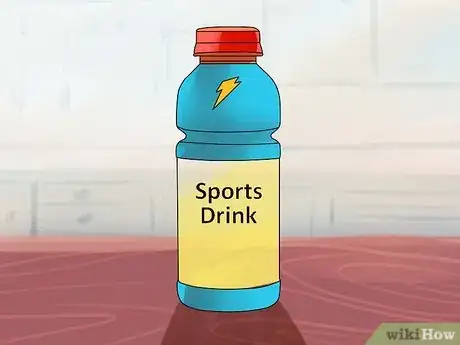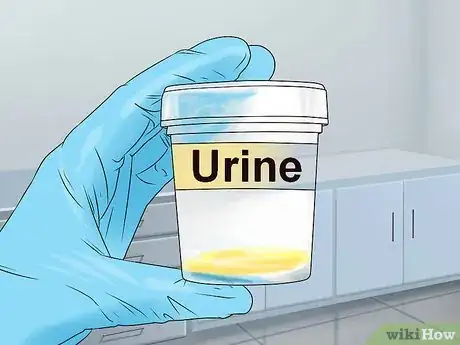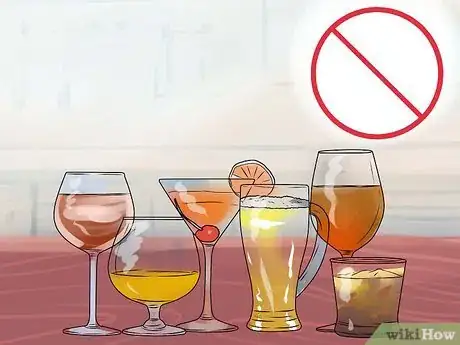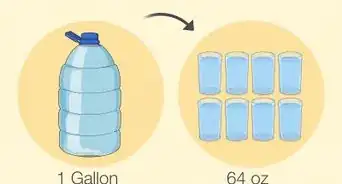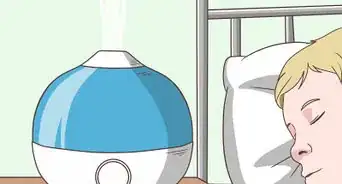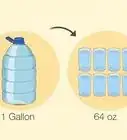This article was co-authored by Georgia Grey. Georgia Grey is a Holistic Health Coach and the Owner of Whole Body Healing Nutrition. With more than five years of experience, she specializes in autoimmune disorders, Lyme disease, and inflammation. Georgia earned a BA from Southern Methodist University and a Degree in Advanced Hormone Health from the Institute of Integrative Nutrition. She is also a Certified Holistic Health Coach through the Institute for Integrative Nutrition and a Certified Holistic Health Practitioner through the American Association of Drugless Practitioners.
wikiHow marks an article as reader-approved once it receives enough positive feedback. In this case, 100% of readers who voted found the article helpful, earning it our reader-approved status.
This article has been viewed 65,114 times.
Water is a vital part of your health and well-being. While common wisdom tells you to consume eight glasses a day, the Institute of Medicine actually recommends 9 to 13 cups (2 to 3 liters) of fluids each day.[1] With a busy schedule, it can be hard to remember something as simple as drinking water. There are a variety of steps you can take to prioritize drinking water. Small changes to your routine, such as bringing a water bottle to work each morning, can help you make drinking water a habit.
Steps
Drinking More Water
-
1Have a glass of water each morning. Before going for a cup of tea or coffee, have a glass of water each morning. Try to make this a daily habit. At first, pouring water down your throat each morning may feel difficult, especially if you're not used to drinking early in the morning; however, after a few days you should get used to drinking water early in the morning.[2]
- If you're not a morning person, you may forget to drink a glass of water right away. It may be a good idea to leave yourself a note in a place you'll look right away in the morning, like near the fridge or coffee pot.
- You can also set a daily reminder on your phone about drinking a glass of water. You can schedule it to go off each morning just after you wake up.
-
2Carry a water bottle. Oftentimes, people forget to drink water simply because of a lack of access. If you don't have water near you during work or school, you may neglect to drink it. Try carrying a water bottle with you throughout the day. Keep it at your desk at work or place it in the book bag you take to class.[3]
- Try to pick a quality water bottle that will not break easily. If you have to spend a little extra money for a higher quality water bottle, it may be worth the cost.
Advertisement -
3Stop at drinking fountains whenever you can. Try to make a point of taking the opportunity to drink water whenever you can. If you see a water fountain, stop and take a sip. Even if you're not feeling thirsty, make a point of stopping at a fountain to drink. These small sips of water will add up, resulting in an increased fluid take throughout the day.[4]
-
4Drink water with each meal. Go for water with all your meals instead of juice, coffee, tea, or alcoholic beverages. Have a glass of ice water when you eat at home. When you dine out, tell the waiter you're fine with water as a drink. Take a large sip of water before starting your meal. Then, take sips of water in between bites. Not only will this up your overall fluid intake, it will help you feel full faster.[5]
-
5Flavor your water. Many people dislike water due to the lack of taste. You can take steps to flavor your water to help you enjoy it more, giving you the incentive to drink it.
- You can infuse your water with fruit to help increase the flavor. Try adding kiwi, strawberries, lemons, or lime to tap water.[6]
- Lemons have low sugar content, by adding them to your water you also get an increase in Vitamin C uptake.
- You can also buy flavored waters at the local super market. Just make sure to read the label. Make sure the waters are flavored with natural ingredients and do not contain added sugar.
Hydrating from Other Sources
-
1Drink a glass of water for every non-water beverage you consume. You can use other liquids as an incentive to drink more water. Make a point of drinking one glass of water for every non-water beverage you consume. If you have one glass of orange juice with breakfast, drink one glass of water as well.[7] Two cups of coffee in the morning? Match it with two glasses of water.
- This can be particularly helpful when drinking alcoholic beverages. If your stomach is filled with water, this can prevent binge drinking as you'll have less room for booze. Hydrating when drinking can also help prevent hangovers.
-
2Eat water-based fruits and vegetables. Your water content does not have to be limited to pure drinking water. Your body will also benefit from water-based fruits and veggies. Go for radishes, zucchinis, lemons, raspberries strawberries, grapefruit, cucumbers, and celery.[8]
- Fruits and vegetables can also be blended and turned into a smoothie to increase to help increase the uptake of water.
-
3Consider sports drinks. If you exercise heavily throughout the day, you may benefit from sports drinks. Sports drinks not only help replace fluids, they also replenish things like sodium, potassium, and electrolytes. In an exhilarating workout, these substances are often drained from your body. If you exercise intensely, consider having a sports drink after a workout.[9]
- Remember that sports drinks are loaded with sugar, so to really get the most from them, dilute them. Fitness enthusiasts recommend six parts water to one part sports drink; however, just watering it down to equal parts water and sports drink is a great start to help you get more hydration. Over time, just add enough sports drink to your water to flavor it.
-
4Make homemade popsicles. Homemade popsicles are a fun and healthy treat that can help you up your fluid intake. You can puree your chosen fruit in a blender, mix it with enough water to create a paste, and place the mixture in an ice tray. Stick a toothpick or popsicle stick in the molds and leave overnight to freeze. In the morning, you can enjoy a nutritious, water-filled popsicle.[10]
- Try to go for some of the water-based fruits, like strawberries, listed above for added fluid intake.
Avoiding Dehydration
-
1Assess your personal needs. When it comes to avoiding dehydration, you want to see how much water you need. As stated, 9 to 13 cups (two to three liters) of fluid, primarily in the form of water, is necessary for the average person; however, you may need to make a point of drinking more water under certain conditions.
- If you exercise, make sure to drink extra water before, during, and after your workout routine.
- If you're experiencing excess heat or humidity in your area, you'll need to drink more water than usual to make up for fluid lost through sweat.
- When you're sick, particularly if you're vomiting or experiencing diarrhea, you'll need to drink more water to make up for lost fluids.
- If you're pregnant or breastfeeding, you'll need more water. It's recommended that pregnant or breastfeeding women consume about 10 to 13 cups (2.4 to 3 liters) of water a day.[11]
-
2Watch urine color. A good way to assess if you're getting enough water is looking at your urine color. Clear or pale yellow urine indicates you're consuming a healthy amount of water. Darker yellow urine indicates you need to up your fluid intake.[12]
-
3Track your water intake. You should make an effort to make sure you're getting enough water. Try to keep a log, on your phone or in a journal, of how much water you're drinking each day. If you have a smartphone, there are many apps you can purchase that help you keep track of your daily water consumption.[13]
-
4Avoid certain beverages. If you want to stay hydrated, certain beverages should be avoided. Certain fluids promote dehydration and should not be a part of a healthy diet.
- Alcoholic and caffeinated beverages can cause dehydration. You should drink these beverages in moderation. You should also drink water while drinking alcohol, tea, or coffee to help counteract the effects of these liquids.[14]
- Alcoholic and caffeinated beverages, such as coffee, teas, and colas, promote dehydration. You should avoid such drinks in general.[15]
- Fruit juices are often heavy on carbohydrates and not enough sodium. Try cutting them with 50% water first to help hydrate yourself.[16]
-
5Learn the signs of dehydration. Dehydration can cause serious medical problems. If you or someone you know is experiencing signs of dehydration, seek medical attention as soon as possible. Signs of dehydration include the following:[17]
- Fatigue
- Lack of appetite
- Red or flushed skin
- Light-headedness
- Dry cough
- Dark urine
Expert Q&A
-
QuestionHow do you hydrate a child that won't drink?
 Georgia GreyGeorgia Grey is a Holistic Health Coach and the Owner of Whole Body Healing Nutrition. With more than five years of experience, she specializes in autoimmune disorders, Lyme disease, and inflammation. Georgia earned a BA from Southern Methodist University and a Degree in Advanced Hormone Health from the Institute of Integrative Nutrition. She is also a Certified Holistic Health Coach through the Institute for Integrative Nutrition and a Certified Holistic Health Practitioner through the American Association of Drugless Practitioners.
Georgia GreyGeorgia Grey is a Holistic Health Coach and the Owner of Whole Body Healing Nutrition. With more than five years of experience, she specializes in autoimmune disorders, Lyme disease, and inflammation. Georgia earned a BA from Southern Methodist University and a Degree in Advanced Hormone Health from the Institute of Integrative Nutrition. She is also a Certified Holistic Health Coach through the Institute for Integrative Nutrition and a Certified Holistic Health Practitioner through the American Association of Drugless Practitioners.
Holistic Health Coach Sometimes, it's a matter of hiding it. For example, put some vegetables in a smoothie or give them some choices, like “Hey, would you rather put two raspberries in your water or help me squeeze this lemon?” This way, it becomes fun and desirable, instead of something that they have to do.
Sometimes, it's a matter of hiding it. For example, put some vegetables in a smoothie or give them some choices, like “Hey, would you rather put two raspberries in your water or help me squeeze this lemon?” This way, it becomes fun and desirable, instead of something that they have to do. -
QuestionHow much water should I have throughout the day?
 Shari Forschen, NP, MAShari Forschen is a Registered Nurse at Sanford Health in North Dakota. Shari has worked in healthcare since 1996 and her expertise lies in acute care bedside nursing on a medical oncology floor. She received her degree from Medcenter one College of Nursing in 2003 and her Family Nurse Practitioner Masters from the University of North Dakota in 2014. Shari is a member of the American Nurses Association.
Shari Forschen, NP, MAShari Forschen is a Registered Nurse at Sanford Health in North Dakota. Shari has worked in healthcare since 1996 and her expertise lies in acute care bedside nursing on a medical oncology floor. She received her degree from Medcenter one College of Nursing in 2003 and her Family Nurse Practitioner Masters from the University of North Dakota in 2014. Shari is a member of the American Nurses Association.
Master's Degree, Nursing, University of North Dakota This is a great question and can be answered with the question, how active are you throughout the day? In general, with minimal activity, eight 8-ounce glasses is sufficient to maintain hydration. Living in hot climate, exercise and/or sickness can increase hydration needs. Easier methods of monitoring hydration status is by monitoring the color of urine. Pale or clear urine is indicative of adequate hydration status. Also, if you refer to above information, hydration can be more specific when taking your weight and dividing into half and then drinking the amount in ounces.
This is a great question and can be answered with the question, how active are you throughout the day? In general, with minimal activity, eight 8-ounce glasses is sufficient to maintain hydration. Living in hot climate, exercise and/or sickness can increase hydration needs. Easier methods of monitoring hydration status is by monitoring the color of urine. Pale or clear urine is indicative of adequate hydration status. Also, if you refer to above information, hydration can be more specific when taking your weight and dividing into half and then drinking the amount in ounces.
References
- ↑ http://www.mayoclinic.org/water/ART-20044256
- ↑ http://www.huffingtonpost.ca/2015/05/22/drink-more-water_n_7421876.html
- ↑ http://www.emedicinehealth.com/drinking_enough_water-health/article_em.htm
- ↑ http://www.emedicinehealth.com/drinking_enough_water-health/article_em.htm
- ↑ http://www.developgoodhabits.com/daily-water-intake/
- ↑ http://www.huffingtonpost.ca/2015/05/22/drink-more-water_n_7421876.html
- ↑ http://www.huffingtonpost.ca/2015/05/22/drink-more-water_n_7421876.html
- ↑ http://www.huffingtonpost.ca/2015/05/22/drink-more-water_n_7421876.html
- ↑ https://my.clevelandclinic.org/health/diseases_conditions/hic_avoiding_dehydration
- ↑ http://www.huffingtonpost.ca/2015/05/22/drink-more-water_n_7421876.html
- ↑ http://www.mayoclinic.org/water/ART-20044256
- ↑ http://www.emedicinehealth.com/drinking_enough_water-health/article_em.htm
- ↑ http://www.huffingtonpost.ca/2015/05/22/drink-more-water_n_7421876.html
- ↑ https://my.clevelandclinic.org/health/diseases_conditions/hic_avoiding_dehydration
- ↑ https://my.clevelandclinic.org/health/diseases_conditions/hic_avoiding_dehydration
- ↑ https://my.clevelandclinic.org/health/diseases_conditions/hic_avoiding_dehydration
- ↑ https://my.clevelandclinic.org/health/diseases_conditions/hic_avoiding_dehydration
About This Article
To get in the habit of drinking water, start by making it a point to drink a full glass of water as soon as you wake up. You can even leave it on the bedside table the night before so it's ready for you in the morning! Next, carry a water bottle with you and keep it on your desk or in your bag so you can sip on it throughout the day. Then, try to have a full glass of water with each meal. To make water taste a little more interesting, consider adding chunks of fresh fruit, like kiwi, strawberries, lemons, and limes, or stirring a sugar-free flavor packet into it. For tips on getting hydration from other sources, like food, read on!







